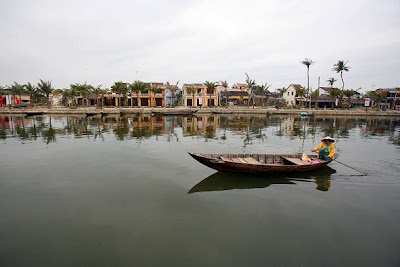
Weed patrol outside the Ho Chi Minh Mausoleum
February in Hanoi is surprisingly cold. For a city on the latitude of Honolulu it's bloody freezing. Not like nippy or chilly, but good old bitter, finger-curling cold. It's so cold that one could walk into the nearest bank wearing a trench coat and a balaclava and not trigger a security alert. Judging from our fellow traveller's fashion faux pas, socks in sandals etc, we weren't the only ones caught by surprise.
Hanoi itself is a curious city, a visible mix of the old and the new. Shiny dead ducks and various unidentifiable meats hang glistening in restaurant windows. Communist symbolism, military heritage and French colonial architecture is everywhere. In the middle of the nation's capital, named after 'A city in a bend of the river', the real estate allows for crusty showrooms featuring industrial machines, sheet metal and wooden agricultural tools. It's definitely a city in transition. 
Shivering tea break on miniature street furniture
All this is surrounded by a new generation of western influence and modern looking mobile phone counters, video shops and internet cafes (yet bandwidth is slow due to the Vietnamese state censorship only allowing one international internet connection for the whole country). Still, it seems the open borders are bringing in the inevitable. The first McDonald's must be opening soon.
Another trademark of Hanoi is crazy traffic. Hundreds of thousands of motor bikes continuously weave in and out of each other, overtaking on both sides with only inches to spare, many loaded like small trucks. This morning we saw one bike with big flabby freshly slaughtered swine and another carrying 20 foot long metal poles, as if doing a spot of jousting in rush hour.
The crowded, narrow streets change their name almost every block, which makes navigation hard. Fortunately they're lined with clusters of adjoining shops specializing in the same products. So we've started memorizing products we see on offer, to find our way to and from the hotel. For instance, the way home today was shoes - clothes - carvings - upholstery - paint - metal. If we'd seen zippers, we'd have gone too far.
Dodging scooters
We also had the bizarre pleasure of visiting the Ho Chi Minh Mausoleum, a majestic marble homage in the middle of Hanoi, surrounded by a brigade of security personnel.
After waiting in a strict queue for camera collection (no photos) with thousands of Japanese, we were led up a closely guarded red carpet stairway to the sacred inner sanctum. There, in a closed glass coffin in a somber room lay Ho Chi Minh himself, meticulously embalmed and manicured (he gets 3 months of Moscow maintenance each year), with glowing pink spotlights on his face and hands which made him look like he was being roasted for dinner. The only thing missing was some spring onion and a few new potatoes.
The casket was flanked by 4 armed security guards, one guarding each corner. In the ceiling above us were a number of criss crossing laser beams worthy of Mission Impossible. Quite a sight.
Getting to Hanoi, travelling up the coast of the South China Sea, was interesting and uncomfortable. Theoretically the long haul coaches in Vietnam are luxurious - reclining beds, air conditioning, TV - but the reality is rather different. The leather beds are short and narrow and the roads less than smooth.
To make matter worse, as soon as we wedged ourselves into our fancy little seats the frigid air con kicked into action, as if we'd been a shipment of bacon needing to be kept fresh. Also, to add insult to injury, a skipping DVD of Vietnamese love ballads looped nearly the entire journey. That's 8 hours from Ho Chi Minh City to Nha Trang. Another 8 hours to Hoi Ann. Then 5 hours to Hue. And finally 14 hours to Hanoi. Which ever way you look at it, that's a whole lot of love ballads. Then again, what doesn't kill us makes us stronger.
Rural farmer
Along the 1000 kilometer journey we saw a strange mix of rural Vietnam. Roadside badminton, buffalo farming, trash burning at night, endless paddy fields, the dredging for a body in a river, a coach crashed into a ditch, and a giant rock fall that forced us to find another road. At night the tiny plastic furniture would come out and people gather around in roadside garages lit by fluorescent tubes, to play cards and feast on big pots of soup. Like we've seen across South East Asia, people seem to work hard during the day and then socialize hard during the evening.
Security at souvenir shop
We stayed overnight in two more Unesco World Heritage cities, Hoi An and Hue, two old trade ports, which have now converted to tourism instead. They had charming pedestrian 'old towns', but like most coastal towns in winter they where pretty sleepy. 
Temple moat reflection
In Hue we took a tour of their famous ancient royal tombs, big moated temple structures with ornately carved stone carps for drain pipes, dragons for steps and massive engraved obelisks. All built by vain royalty who needed confirmation that they would be remembered after their death. One of them allegedly commissioned a poem with 600 verses to be read at his funeral. That ought to do it.
Royal tomb near Hue
For now our main mission is to secure Chinese visas and buy some thermal underpants. Both quite essential. Because it's going to get a lot colder, before it gets warmer. Our next stop is the Chinese border.
On the whole, Vietnam has given us many special moments. Some great, some bad and some just plain bizarre. But what they all have in common is that they've been highly original.
Thank you Vietnam. One day we'll be back.
Hoi An harbour